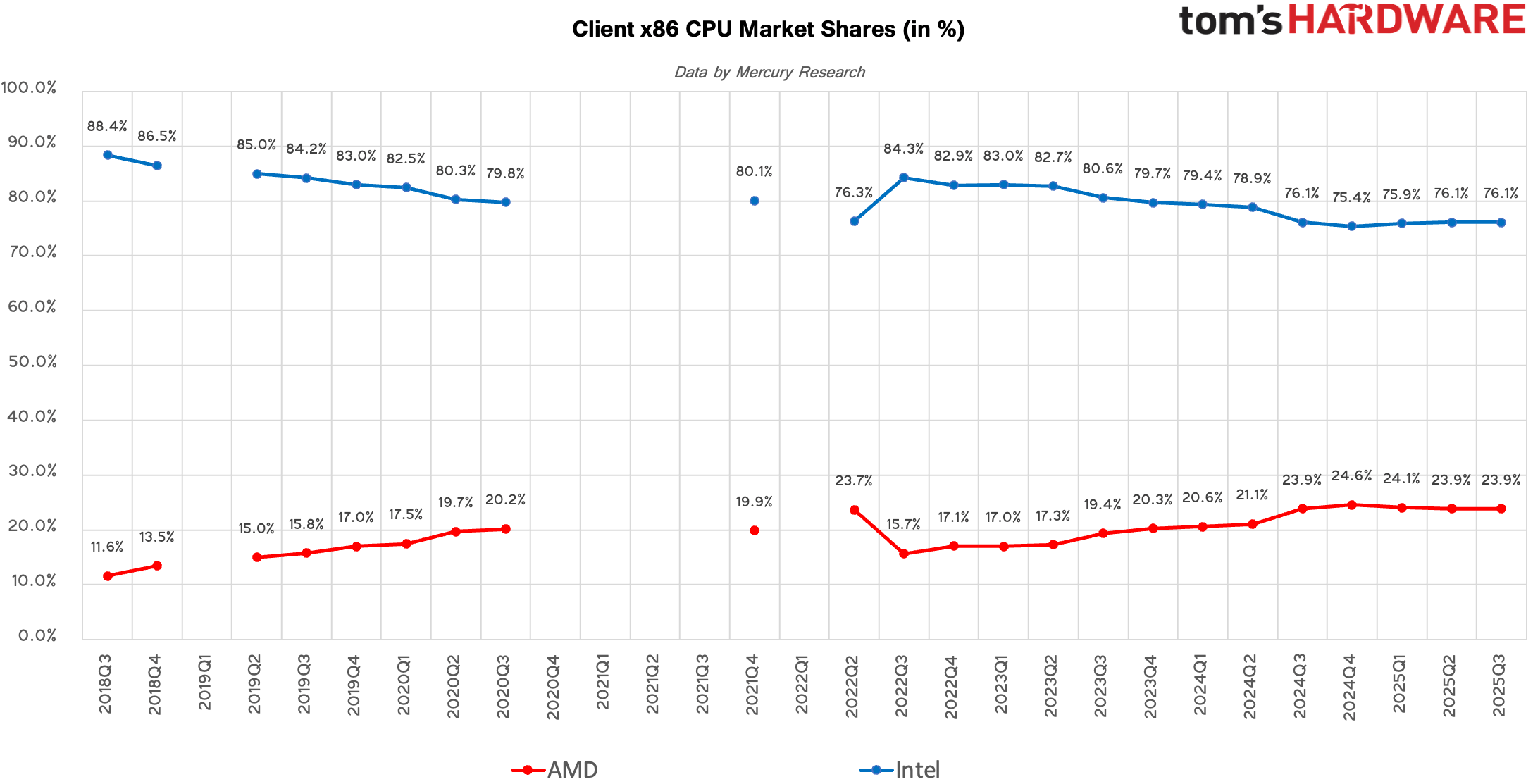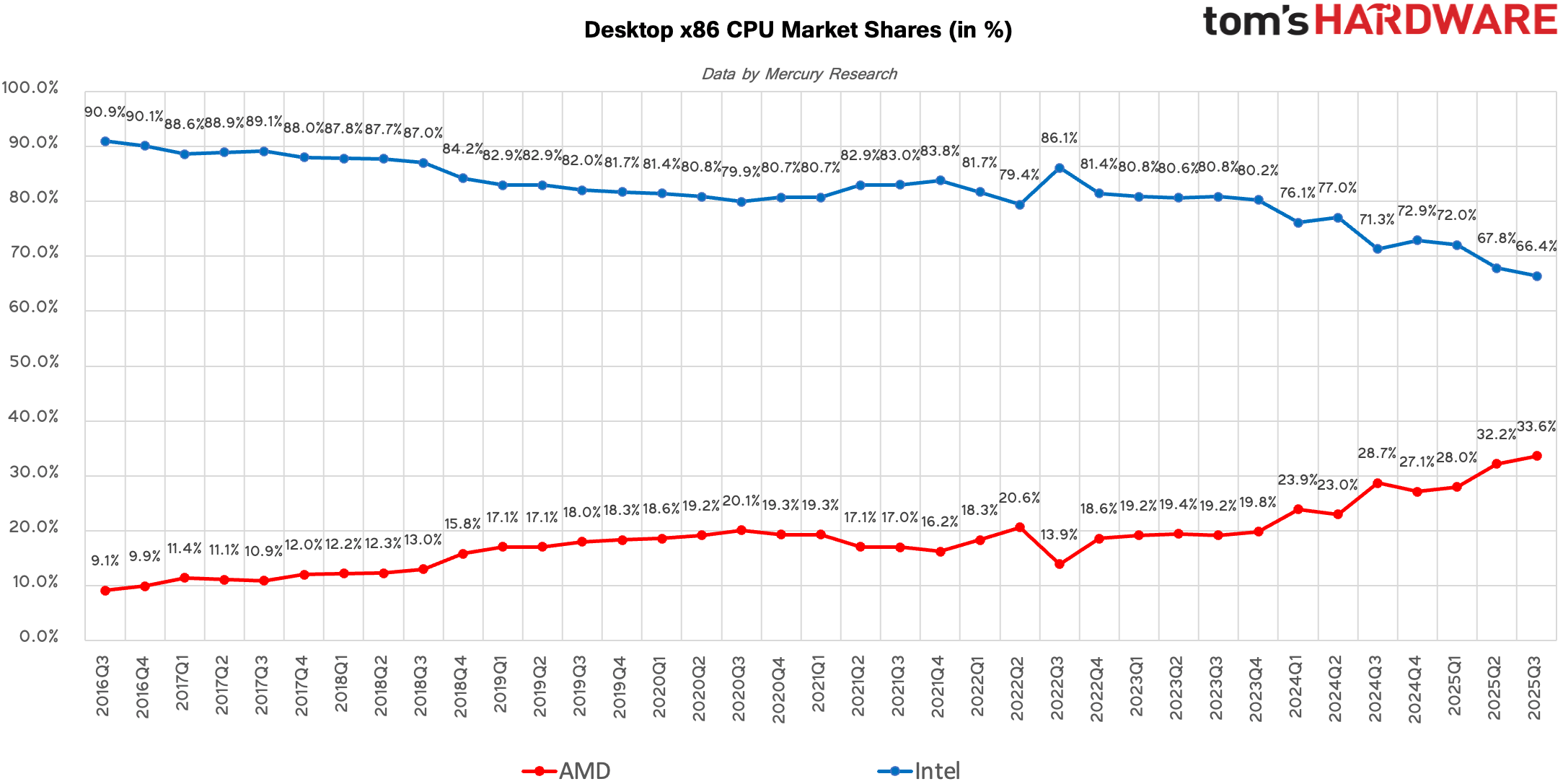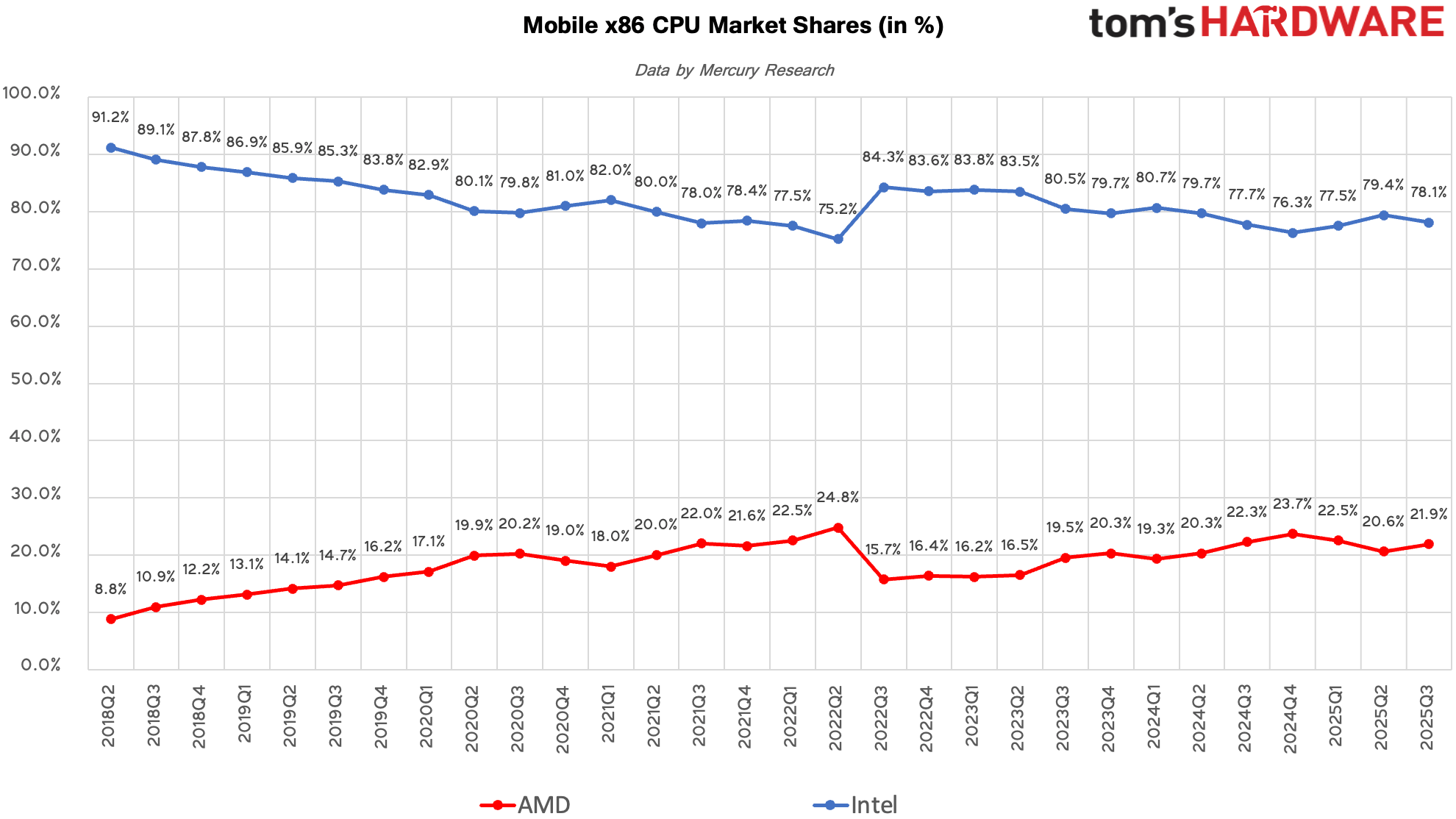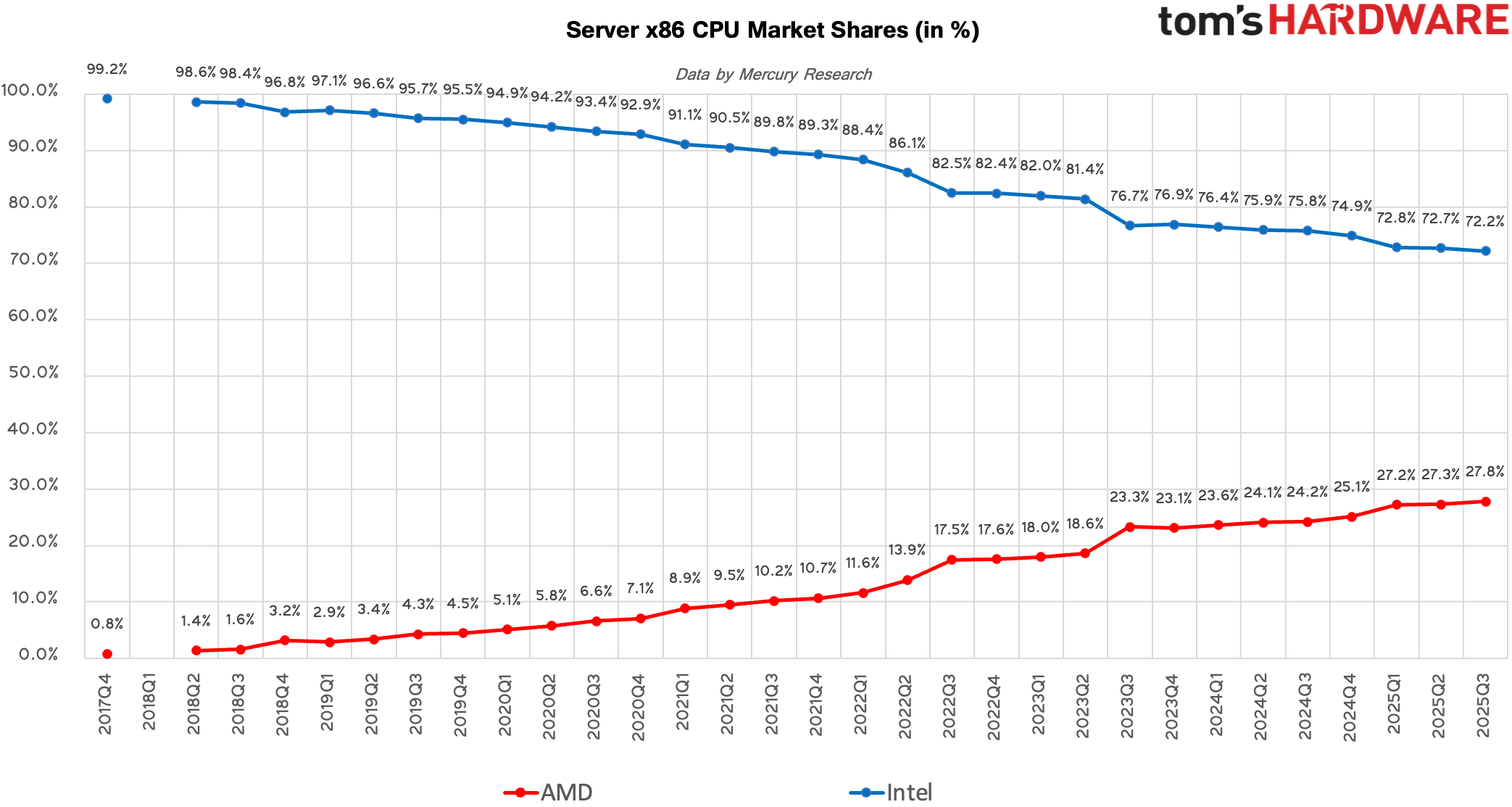AMD continues to chip away at Intel's X86 market share — company now sells over 25% of all x86 chips and powers 33% of all desktop systems

AMD increased its share across all markets served by x86 processors at Intel's expense in the third quarter of 2025, according to Mercury Research. Intel is holding strong, and as its latest offerings for client and server systems got significantly more competitive than they were several quarters ago, the pace of AMD's gains has slowed down considerably. However, during the quarter, AMD achieved two important milestones: it now commands shipments of over 25% of all x86 CPUs, and it now ships over 33% (one-third) of desktop x86 CPUs.
Abnormal market performance: Shipments of x86 CPUs flat quarter-over-quarter
Normally, we start our coverage of the x86 market based on data from Mercury Research with client CPUs, but the third quarter was very unusual as unit shipments of x86 CPUs were flat quarter-over-quarter (QoQ), which significantly contradicts the normal seasonal bump when PC makers start to prep for the back-to-school (BTS) season in June – July as well as Christmas season in September.
Indeed, PC and server makers increased their CPU procurements in Q3, but the weakness came almost entirely from Intel, which saw sharp drops in IoT/SoC and entry-level mobile processors as it shifted manufacturing capacity toward server processors, and strong shipments of such parts in Q2. By contrast, AMD's unit shipments were flat to slightly up, so the company gained share sequentially and year-over-year (YoY), hitting two psychologically important milestones.
For the first time in years, AMD's unit share of all x86 client and server CPUs shipped exceeded 25% and now stands at 25.6%, up from 24.2% in the prior quarter and up from 24% in the same quarter a year ago. Intel still commands 74.4%, but it lost some share in certain segments, allowing AMD to hit an important milestone amid a market shrink.
If we add embedded, IoT, and game consoles SoCs to the equation, then AMD's share looks even more impressive: a 30.9% share of all x86-based chips, up from 25% in the third quarter of 2024. While Intel maintains its dominant position with 69.1%, its 5.9% YoY share loss does not look very good. Yet, it should be noted that AMD shipped significantly more game console SoCs in the third quarter this year compared to the third quarter of 2024, which inflated its results a bit.
Client CPUs: AMD maintains market share
Strong desktop and mobile CPU lineups as well as Intel struggles with supply of small-core mobile CPUs and prior-generation desktop offerings allowed AMD to slightly outgrow Intel in the third quarter both sequentially and year-over-year, according to data from Mercury Research.

AMD's client unit share rose to 25.4%, up 1.5% QoQ and 1.4% YoY, driven mainly by strong desktop momentum. By contrast, Intel's share fell to 74.6%, down 1.5% sequentially and 1.4% compared to the same quarter a year ago, as its entry-level mobile shipments were constrained by reduced small-core CPU supply. Although Intel still dominates in total volume, Q3's numbers reflect the ongoing pressure on its mobile PC shipments and AMD's sustained improvement in desktops.
Get Tom's Hardware's best news and in-depth reviews, straight to your inbox.
Desktop CPUs: Another great quarter for AMD
Both AMD and Intel saw strong sequential unit shipments growth in Q3 2025 on the desktop CPU market, although Q2 -> Q3 market growth in general was lower than normal seasonal rates, according to Mercury Research.

AMD grew far faster thanks to the popularity of its Ryzen 9000-series 'Granite Ridge' CPUs in the enthusiast and performance tiers, allowing the company to reach another all-time high: a 33.6% share of the desktop PC market, up from 32.2% in the prior quarter and a gain of 5.2% year-over-year. If we compare AMD's current share to its share in the second quarter of 2024, the gain would be a whopping 10.6%
Intel still held the majority of desktop shipments, but its share fell from 67.8% to 66.4% QoQ, and from 71.7% YoY, reflecting AMD’s continued gains in both the mainstream and high-end segments and shortages of Intel's 13th and 14th Core 'Raptor Lake' processors that are still popular three years after their original release in 2022.
On the revenue front, AMD reached another record quarter for desktop CPU revenue, driven by higher shipments and a strong mix of premium SKUs, as the company noted in its conference call a week ago. Intel's revenue position weakened as its unit share declined and AMD absorbed more of the market's high-margin demand. Mercury Research notes that AMD's revenue growth in desktops significantly outpaced its unit growth, which confirms that the red company continued to strengthen its position in the most profitable parts of the desktop market.
Mobile CPUs: AMD starts to regain share
AMD lost market share to Intel in the mobile CPU space in Q1 and Q2 2025, but the company outperformed Intel in Q3 2025 on a sequential basis, gaining unit share as Intel struggled with reduced shipments of its entry-level small-core processors.

AMD's mobile CPU unit share rose from 20.6% in Q2 to 21.9% in Q3, a sequential gain of 1.4%, while Intel's share fell from 79.4% to 78.1%, down 1.4% QoQ. Intel did manage to grow shipments slightly, but well below normal seasonal levels, allowing AMD to capture market share during the quarter, according to Mercury Research. Nonetheless, AMD lost 0.4% market share year-over-year, whereas Intel gained 0.4%.
On the revenue side, the mix probably favored both companies but helped AMD more. Intel's shortage of low-end CPUs pushed its average selling prices upward, while AMD — which does not have direct rivals for Intel Atom-like SoCs — benefited from increased shipments of mid-range and premium Ryzen mobile processors as Intel faced some shortages on this side of the spectrum as well.
Server CPUs: AMD stagnates amid product mix improvement
In the server CPU market, Q3 2025 saw relatively flat unit shipments overall, but while AMD managed to edge out another small gain, its gains have been negligible this year. Then again, although the sequential movement was modest, it continued the longer-term trend of AMD steadily expanding its presence in x86 servers.

AMD's server unit share increased from 27.3% in Q2 to 27.8% in Q3, while Intel's share slipped 0.5% to 72.2%. Both companies saw YoY shipment growth, but AMD's increase was stronger, helping it push unit share higher compared to the same quarter a year earlier, so overall things look good for AMD.
Most of the real action in Q3 came from product mix rather than volume, according to Mercury. AMD's EPYC 'Turin' ramp accelerated, driving stronger demand for high-core-count EPYC processors, while Intel saw increasing adoption of Xeon 6 'Granite Rapids,' which helped lift its average selling prices despite slightly lower unit volumes.
On the revenue side, AMD hit another all-time high, as the mix shifted heavily toward its latest and more expensive EPYC 9005-series platform. The combination of flat unit shipments and rising prices meant that AMD's server revenue continues to grow significantly faster than its unit share, while Intel's revenue gains were more limited due to modest declines in its overall shipment mix.
Summary
In terms of unit share, AMD continued to gain ground in Q3 2025 across nearly all major x86 segments, helped by strong desktop growth driven by the halo effect of range-topping Ryzen 9000-series CPUs and Intel's struggles to ship enough previous-generation desktop CPUs, as well as the relatively low popularity of its latest offerings for desktops. As a result, AMD expanded its presence in client CPUs, reached a new high in desktops, and inched upward in servers, while Intel's share declined modestly as supply constraints and product transitions limited its ability to address all orders. Although Intel still led the market in total shipments, the balance continued shifting gradually toward AMD.
In terms of revenue, AMD delivered even stronger results, setting new highs in both desktop and server segments thanks to rising sales of premium processors and the ramp of its newest platforms. Intel's revenue performance was more mixed: constrained low-end supply pushed its average prices higher, but it ceded more of the high-margin market to AMD, especially in desktops and enterprise servers. Then again, the company announced price hikes of its popular Raptor Lake processors, which will impact its results in Q4.

Follow Tom's Hardware on Google News, or add us as a preferred source, to get our latest news, analysis, & reviews in your feeds.

Anton Shilov is a contributing writer at Tom’s Hardware. Over the past couple of decades, he has covered everything from CPUs and GPUs to supercomputers and from modern process technologies and latest fab tools to high-tech industry trends.
-
CerianK I performed a little bit of math, and I find it interesting that those with AMD desktop CPUs seem to be almost twice as likely to report results to PassMark, which skews their results to make it look like AMD and Intel each have about a 50% share. Of course PassMark is aware of this, and notes this effect, but I had not calculated it before.Reply